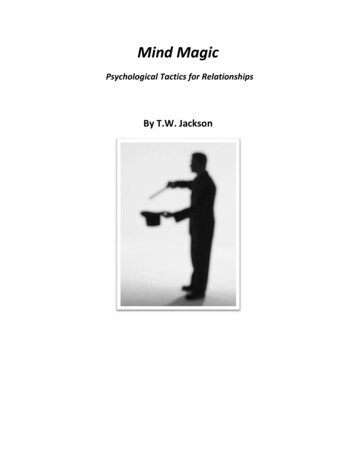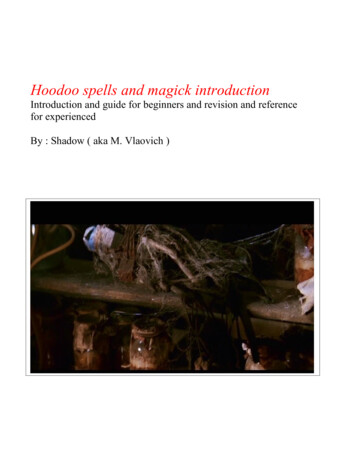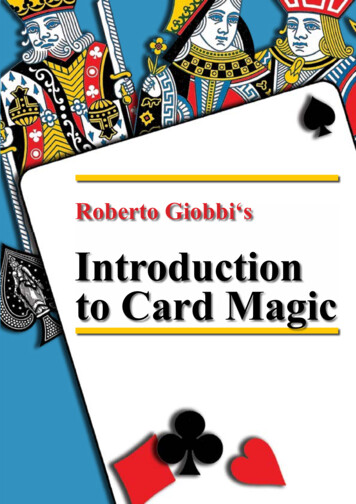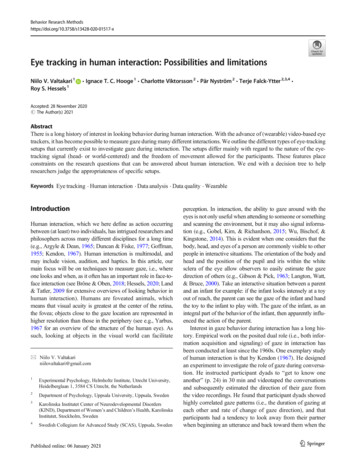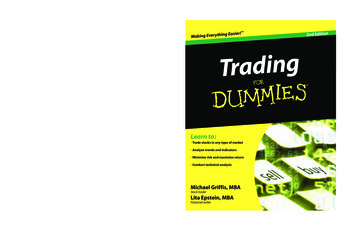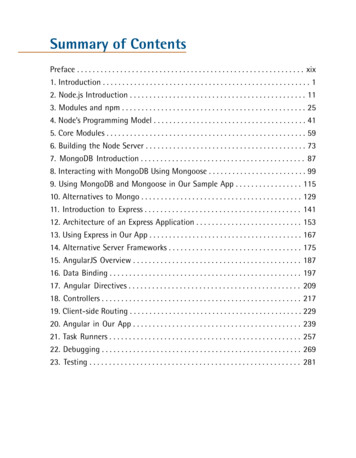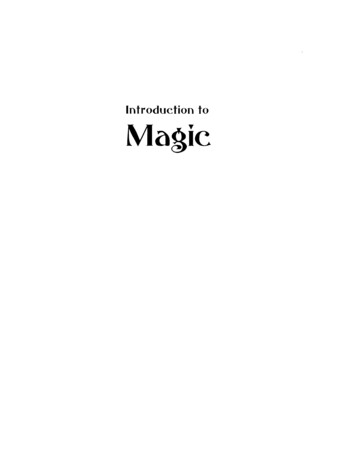
Transcription
Introduction toMagic
Introduction toRituals andPractical Techniquesfor the MagusJULIUS EVOLAand the UR GroupTranslated by Guido StuccoEdited by Michael MoynihanInner TraditionsRochester, Vermont
Inner Traditions InternationalOne Park StreetRochester, Vermont 05767www. InnerTraditions. comFirst U.S. edition published by Inner Traditions in 2001Originally published in Italian under the title Introduzione alia Magia qualescienza dell'Io, Vol. 1 by Edizioni Mediterranee—Rome, 1971Copyright 1971, 2001 by Edizioni Mediterranee—RomeEnglish translation copyright 2001 by Inner Traditions InternationalAll rights reserved. No part of this book may be reproduced or utilized in anyform or by any means, electronic or mechanical, including photocopying,recording, or by any information storage and retrieval system, without permission in writing from the publisher.Library of Congress Cataloging-in-Publication DataIntroduzione alia magia. Vol. 1. English.Introduction to magic : rituals and practical techniques for the magus / JuliusEvola and the UR Group ; translated by Guido Stucco.—1st U.S. ed.p. cm."Originally published in Italian under the title: Introduzione alia Magia, vol.1 . . . 1971."ISBN 0-89281-624-4 (alk. paper)1. Magic. I. Evola, Julius, 1898-1974. II. Gruppo di UR. III. Title.BF1611 .158 2000133.43—dc2199-089368Printed and bound in the United States10 9 8 7 6 5 4 3 2 1Text design and layout by Priscilla BakerThis book was typeset in Berkeley with Abbess and Stone Sans as display faces.
ContentsEditor's NoteixPreface: Julius Evola and the UR Groupby Renato Del Ponte xiIntroduction2IPIETRO NEGRI Sub Specie InterioritatisLEO BarriersABRAXASLUCE 813 Knowledge of the Waters15Opus Magicum: Concentration and SilenceEA The Nature of Initiatic Knowledge2126IIThe Path of Awakening According to Gustav MeyrinkLUCE Opus Magicum: FireABRAXAS Three WaysLEO Attitudes34414652Commentaries on the Opus Magicum55IIILEO First Steps Toward the Experience of the "Subtle Body"Knowledge as LiberationABRAXAS64 The Hermetic Caduceus and the Mirror7260
LUCE Opus Magicum:The "Words of Power" and the Characters of BeingsPIETRO NEGRI Knowledge of the Symbol7983IVApathanatismos: Mithraic Ritualof the Great Magical Papyrus of Paris 98VSummary130ABRAXAS Instructions for the "Awareness of Breath"Oso Notes on the Logos135AROM First Experiences141EA The Problem of Immortality133144VILEO Beyond the Threshold of SleepEA On the Magical View of LifeABRAXAS152156 The Second Preparation of the Hermetic CaduceusIAGLA Experiences: The Law of Beings167The Path of Realization According to BuddhaVarious Commentaries173181VIILUCE Instructions for Ceremonial Magic186EA The Doctrine of the "Immortal Body"196De Pharmaco Catholico203160
vmABRAXAS Magical Operationswith "Two Vessels"—Reduplication 2 1 8Tibetan Initiatic Teachings:The "Void" and the "Diamond-Thunderbolt" 2 2 8ARVO On the Counter-Initiation 2 3 5LUCE Opus Magicum: Perfumes243IXARVO Conscious Thought—Relaxation—Silence 2 5 2EA Considerations on Magic and Its Powers 2 5 7ABRAXAS Magic of the Image 2 6 6PIETRO NEGRI An Italian Alchemical Text on Lead Tablets273XLUCE Opus Magicum: Chains296LEO The Attitude Toward Initiatic Teaching 3 0 0EA Freedom, Precognition, and the Relativity of Time 3 0 4Commentary on the Opus Magicum 3 1 5XIIAGLA Serpentine Wisdom318LUCE Invocations 3 2 4Excerpts from De My stems 3 2 9The Message of the Polar Star 3 3 4SIRIUS Mist and Symbols 3 3 5EA On the General Doctrine of Mantras 3 3 8
XIIALBA De Naturae Sensu 3 4 8LEO Aphorisms 3 5 7PIETRO NEGRI Adventures and Misadventures in MagicVarious Commentaries 3 6 8
Editors NoteIntroduction to Magic is a complex book that presented numerous hurdlesfor both translator and editor. A primary example of this can be seen in theItalian title Introduzione alia Magia quale scienza dell'lo (literal translation:introduction to Magic as a Science of the I"). The fundamental theme ofthe book concerns the training and development of this "Io," a term forwhich it is difficult to find a suitable English equivalent. The word ego isnot an appropriate choice, in part due to connotations from modern psychoanalysis. Use of the English first person "I" as an impersonal noun isawkward, and therefore the best solution was to utilize the term Self, capitalized as a proper noun.Other obstacles in translation arose from the unusual nature of the book'scontents. The contributors came from various backgrounds and their individual writing styles reflect this. It would be inappropriate to reducethem to one homogeneous prose; the reader will therefore notice inconsistencies among the authors and articles, especially with regard to uniquepreferences for capitalization, punctuation, and emphasis. We have generally left these idiosyncrasies intact, in order to convey accurately what theoriginal readers of the journal Ur had in front of them.When dealing with foreign documents (e.g., the Tantric and Buddhisttexts, or the Mithraic Ritual) we have not referred to modern translationsof these works, but instead have returned to sources closer to those textsthat the UR Group used when preparing their own translations.We have introduced some clarifications to aid the modern reader. Translations are given for most of the Latin words and phrases, and we have alsoprovided transliterations of ancient Greek terms when this serves to illuminate the author's message (notably in the essay "Knowledge of the Symbol" by -Pietro Negri").The footnotes throughout the book are either from the author of a givenessav or. when indicated, by the UR Group as a whole (although, as Renato
XEditor's NoteDel Ponte points out in his preface, these notes were most likely written byEvola). We have provided some additional footnotes, which are alwaysindicated as "Editor's notes." The precedent for some of these notes comesfrom the German edition of Introduction to Magic, edited and translated byDr. H. T. Hansen, to whom we are indebted for allowing us to draw fromhis work. A grateful acknowledgment is also given to Joscelyn Godwin,who made an immense amount of contributions toward revising and refining the English translation of Introduction to Magic. The degree to whichthis edition reflects the subtleties of meaning originally invested into thematerial by the UR Group is largely due to his input.A piece of advice offered by Dr. Hansen to German readers of the bookis equally valid for the present edition: Although much effort has been expended in making this translation as clear as possible, we recommend that itbe read using the "ears of the heart," for a certain freedom of thewasunavoidable.translation
PrefaceJulius Evola and the UR, GroupRenato Del PonteT h e collaboration that Julius Evola sought out at the end of the 1920swith the most interesting figures of Italian esotericism to form the famousUR Group, aside from the example it has provided and continues to provide to anyone seriously engaged in the esoteric sciences, is also extremelyimportant in the overall context of Evola's work. For it was precisely during this period that he came to expand his own interests in the real, timehonored realms of Tradition, and at least two of his principal works, RevoltAgainst the Modern World and The Hermetic Tradition, are contained in seedform in some of the monographs published by UR. The attendant experiences with the UR Group should therefore not be neglected, for in order toclarify essential points necessary to a comprehension of the spirit of Evola'slifework, indeed it is necessary to investigate the precedents, limits, andoutcomes of their endeavors.The PreliminariesThe journals Atanor (1924) and Ignis (1925), both edited by Arturo Reghini,can be considered direct antecedents of Ur} During the two brief years oftheir existence (Jgnis enjoyed a fleeting revival in January 1929), these twojournals of "initiatic studies" confronted esoteric themes and disciplines*This essay originally appeared in R. Del Ponte's Evola e il magico "Gruppo di Ur":Studi e documenti per servire alla storia di "Ur-Krur," published by SeaR Edizioni,Borzano, 1994. It is here translated by Tami Calliope.1. Arturo Reghini ( 1 8 7 8 - 1 9 4 6 ) was born in Florence, the descendant of a very ancientfeudal family from Pontremoli that branched out and established themselves inFlorence and Rome in the second half of the 1700s. Reghini was one of the mostfamous Italian scholars of the Tradition in the first half of the twentieth century, the
xiiPREFACEwith a scientific rigor and seriousness uncommon to the heterogeneousspiritualistic environment of the era. The themes, which were always ofexceptional interest, ranged from Pythagoreanism and Tantrism to theKabbalah and the secret documents of Cagliostro's trial. It was here, inItaly, that the writings of Rene Guenon were first published, including hisprincipal versions of Eesoterisme de Dante (The Esotericism of Dante) andLe roi du monde (The King of the World, translated by Reghini), whichonly later came out in France in 1925 and 1927, respectively. AmongReghini's contributors we find names that will crop up again in the URGroup: Aniceto Del Massa, "Luce" ("Light," pseudonym of Giulio Parise),and, aside from Reghini himself, Julius Evola.Apart from some critical reviews, Evola, who was then twenty-six yearsold, contributed a long essay to Atanor in installments on Lapotenzacomevalore metafisico (Power as a Metaphysical Value), which was later incor-major interpreter of Neo-Pythagorean thought, and the exponent of an unmitigated,intransigent, anti-Christian, pagan directive. He exerted considerable influence onEvola's thinking between the years 1924 and 1928, primarily during the period in whichhe composed his Imperialismo pagano (Pagan Imperialism, first published in 1928 andreprinted in 1978). The books title actually originates from a 1914 article of Reghini'sthat was later reproduced in the third issue of Atanòr.Reghini was the creator (with E. Frosini and others) of the "Italian PhilosophicalRite" ( 1 9 0 9 ) within the circle of contemporary Freemasonry; he also welcomed theEnglish magician Aleister Crowley as an honorary member in 1911. Aside from numerous articles and essays published in the journals Ultra, Rassegna Massonica, MondoOcculto, and II Leonardo, he counted among his many works Le parole sacre e di passo deiprimi tre gradi e il massimo mistero massonico (The Sacred Passwords of the First ThreeDegrees and the Greatest Masonic Mystery, 1922, with numerous republications); Per larestituzione della geometria pitagorica (An Apology for the Restitution of PythagoreanGeometry, 1935, reprinted in 1978); and I numeri sacri della tradizione pitagoricamassonica (The Sacred Numbers of the Pythagorean Masonic Tradition, 1947, reprintedin 1978). These last two are now reunited under the title Numeri sacri e geometrìapitagorica (Sacred Numbers and Pythagorean Geometry, published by I Dioscuri, Genoa,1988). Other notable works were Aritmosofia ( 1 9 8 0 ) ; Il simbolismo dodecimale e il fascioetrusco (Twelve-based Symbolism and the Etruscan Fasces, 1934, reprinted in 1981); anda posthumous collection of articles called Paganesimo, pitagorismo, massoneria (Paganism, Pythagorism, and Freemasonry, 1986). Of his principal work, entitled Dei numeripitagorici (On Pythagorean Numbers), divided into three parts, seven books, and aprologue, only the prologue has been recently published (by Ignis, Ancona, in 1991),
xiiiPREFACEporated into Iluomo come potenza(Man as Power) in 1926. In Ignis he2published essays on Steiner, on "the feminine," and a lecture, "Dionysius,"which was included in 1926 in the small volume Eindividuo e il divenire delmondo (The Individual and the Becoming of the World).3Apart from his work in the artistic field of the avant-garde, which does notconcern us here, by this time Evola had to his credit the powerful Saggisull'idealismo magico (Essays on Magic Idealism, 1925) and countless contributions to spiritualist and philosophical journals of the era, such as Ultra, a publication of the Independent Theosophical League of Rome, edited by Decio Calvari; Bilychnis'*; and Idealismo Realistico (Realistic Idealism). In a letter of his dated 1925 and written on stationery bearing thename of this last journal, he makes it clear that he had already completedTeoria dell'Individuo Assoluto (Theory of the Absolute Individual) somewith an appendix of letters and testimonials. In 1980 Atanor Editions of Rome publisheda reprint of the complete collections of Atanor and Ignis.Of late there has been a vast resurgence of interest in Arturo Reghini and his works;see the historic essay by M. Rossi, "Linterventismo politico-culturale delle rivistetradizionaliste negli anni Vend: Atanor (1924) e Ignis (1925)" (The Political-culturalIntervention of Traditionalist Journals in the Twenties), published in StoriaContemporanea, XVIII, 3 (June 1987), pp. 4 5 7 - 5 0 4 ; and the even more recent, brief butsignificant profile by E. Zolla, "Arturo Reghini, Pitagorista" (Arturo Reghini,Pythagorean), published in Leggere, 3 (March 1989), pp. 4 6 - 4 7 . Many of Reghini's workshave been translated into French by Arche Editions of Paris and Milan.2. Luomo come potenza, completely reworked and revised, reappeared in 1949 as Lo Yogadella potenza (The Yoga of Power, published by Bocca, it was later reprinted by EdizioniMediterranee in 1968; English edition Rochester, Vt.: Inner Traditions, 1992). Theoriginal edition, prefaced by an introductory essay by P. Fenili, has been republished byEdizioni Mediterranee in Rome in 1988.3. L'individuo e il divenire del mondo was reprinted in 1976 by Arktos Editions inCarmagnola.4. All of Evola's articles and reviews from Bilychnis are now compiled in ], Evola: I saggidi Bilychnis (The Essays in Bilychnis), published in 1987 by Ar in Padua. Evola was ableto contribute to that
Introduction to Magic is a complex book that presented numerous hurdles for both translator and editor. A primary example of this can be seen in the Italian title Introduzione alia Magia quale scienza dell'lo (literal translation: introduction to Magic as a Science of the I"). The fundamental theme of the book concerns the training and development of this "Io," a term for which it is difficult .

